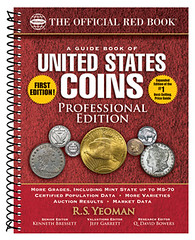
PREV ARTICLE
NEXT ARTICLE
FULL ISSUE
PREV FULL ISSUE
BOOK REVIEW: A GUIDE BOOK OF UNITED STATES COINS (PROFESSIONAL EDITION)
Michael E. Marotta submitted this review of the new Professional Edition of Whitman Publishing's A Guide Book of United States Coins: "Old Markets and New Typography"
-Editor
Perhaps most buyers of The Professional Edition will do nothing more than look up a price. However, studying the book for its metadata reveals the complex texture of collectible U. S. federal coinage. Large Cents are not Morgan Dollars. Pricing tables for the former begin with Very Fine up, whereas for the latter, only Mint State grades are tabulated. Similarly, the earliest Half Dimes are considered only for grades equal to or greater than EF-40, but the Draped Bust has a lower foundation, VF-20, because that is the reality of the market today. The database schema accurately models more than today's markets. Large Cents have been pursued by pure hobbyists since the days of Lorin G. Parmelee and Edward Cogan. In the baby boom generation and before, amateur collectors monitored the media of daily commerce for a better circulated grade of an uncommon coin. Of course, today, that is greatly diminished. More to the point, it was never the modality of the professional aficionado for whom citations to recent auctions always were more important than guesstimates of price. As collecting expanded and matured, the inventories of specimens in the highest grades grew. You can still build a nice collection of Jefferson Nickels with Full Steps by searching pocket change or bank bags, but the fact remains that nothing less than Full Steps is worth searching for. This book acknowledges that reality. Intersecting sets of passions drive us numismatic bibliomaniacs. Whitman has established its own style for footnotes. The usual sequence is asterisk, dagger, double dagger, section mark, parallels and number sign, beginning at the top of the page. However, Whitman gives primacy to mintages. Therefore, the frequent note "Included in number above" always receives the asterisk and appears as the first footnote, regardless of where the noted tally appears on the page.
Next come the double and triple asterisks for other notes about mintages. Then comes the dagger. Whitman also relies on an alphabetic series (lowercase) to elucidate details of named varieties. Each sequence reinitializes with the major type, a-h for Liberty Seated Half Dollars, for example. None of this detracts in any way from the craft of this work It is merely a convention demanded by the subject matter, a nod to our uncommon and important library of knowledge.
The Numismatic Bibliomania Society is a non-profit organization promoting numismatic literature. See our web site at coinbooks.org. To submit items for publication in The E-Sylum, write to the Editor at this address: whomren@gmail.com To subscribe go to: https://my.binhost.com/lists/listinfo/esylum All Rights Reserved. NBS Home Page Contact the NBS webmaster 
|
